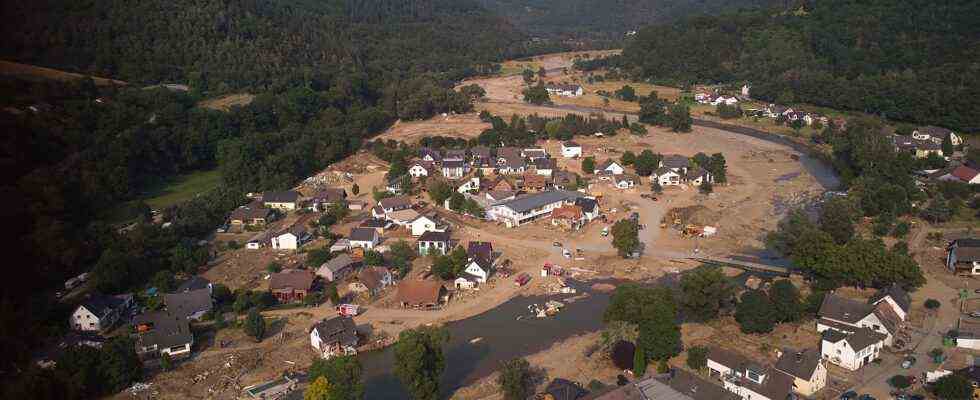Status: 07/29/2021 2:54 p.m.
Two weeks after the devastating floods in the Ahr Valley, many people are wondering how this catastrophe came about. Why weren’t residents warned earlier?
Two weeks after the flood disaster in the Ahr Valley, church bells are ringing in many places. District Administrator Jürgen Pföhler has called on all citizens of the Ahrweiler district via Twitter to pause for ten minutes and to commemorate the victims together.
14 days have passed since the night that radically changed life in the region. At 7:50 p.m. on July 14, 2021, many had no idea what disaster awaited them.
Could the dead have been prevented?
Many people have long been asking themselves: Could the catastrophe have been prevented, at least the dead? In Rhineland-Palatinate alone, 134 people died, 766 were injured and 73 are still missing.
“Believe me how often I think about it”, the Rhineland-Palatinate Interior Minister Roger Lewentz is quoted again and again days after the accident. Of course one could have evacuated, but that was not his decision, it was that of the district.
“Only the district administrator and the responsible fire and disaster control inspector could have known that from the experience of 2016,” the interior minister told the press.
A disaster with an announcement?
2016 was the last flood, but not the only one. At that time the water of the Ahr rose from the normal 90 centimeters to 3.79 meters. Numerous cellars, streets and bridges were flooded. The consequences were devastating. But this time it was to get worse.
As early as July 8, 2021 – six days before the disaster – the European flood warning system had predicted a high probability of flooding. On July 12, 2021, the German Weather Service (DWD) will inform more than 100 contacts in Rhineland-Palatinate, including district administrations and fire departments. The next day, the DWD reinforced its warning: “The next few days will be tough.”
In the late afternoon of July 14th around 5:17 p.m. the water level of the Ahr was 2.78 meters. The State Office for the Environment proclaims the highest warning level. At 5.40 p.m. the crisis team meets around the district administrator in the district administration in Bad Neuenahr-Ahrweiler. Interior Minister Lewentz left the crisis team at around 7.30 p.m. Days later he will say that at that point in time he had the impression that everything was ready. There are experienced people there who also managed the floods in 2016.
Key moment at 7:09 p.m.
At 7:09 p.m. was a key moment for him, District Administrator Jürgen Pföhler later told a newspaper. At the time, the DWD briefly corrected its forecast for the Altenahr gauge from five to a good four meters. “You have to know that,” said the district administrator. However, the DWD quickly corrected the announcement. A correction that apparently did not reach those in charge of the crisis team.
Shortly after 8 p.m., the Mainz State Office for the Environment (LfU) announced a tidal wave of seven meters for the early hours of the next day. At 8:56 p.m., the Ahrweiler district tweeted that there were floods and heavy rain on the Ahr. The current water level is 5.09 meters. More flash floods are to be expected.
A reader writes with reference to the data of the LfU: “575cm larger than a hundred-year flood!” How high the tidal wave actually came can later only be traced in computer models, because at around 8.45 p.m. the water level was torn away from the water at 5.75 meters.
Desperate calls for help from neighbors
Nevertheless, more than two hours passed until at 11.09 p.m. the residents along the Ahr were asked to vacate their houses 50 meters to the right and left of the river. Much too late, say the residents of Bad Neuenahr-Ahrweiler. At this point they have long heard the desperate calls for help from neighbors. Not all of them will see her alive again later.
On the day after the disaster night, District Administrator Pföhler speaks of an “absolute disaster”. The focus is now on rescuing people and performing salvage. Then he cannot be seen for ten days.
The Kurhaus of the municipality of Insul in the Ahr Valley – ten days after the disaster.
Image: dpa
“Reciprocal accusations do not help”
At the request of the district, the state authorities take over the on-site operations management. On July 26th, 2021, Pföhler said in an interview with the Rhein-Zeitung: “In this situation I say very clearly: Reciprocal accusations do not help us at all.” And: “My impression was that all the responsible authorities, the DWD, the Rhineland-Palatinate flood reporting service, the Ahrweiler district and all disaster control units reacted immediately and warned the population at different times.” What then developed was an exceptional situation, according to the district administrator.
When it comes to the question of who had to act when and how, it is not about blaming, say many residents and helpers on the Ahr. Nevertheless, the wish was there to find out why it took so long before the evacuation call came. This is the only way to learn from this for possible future disasters.

